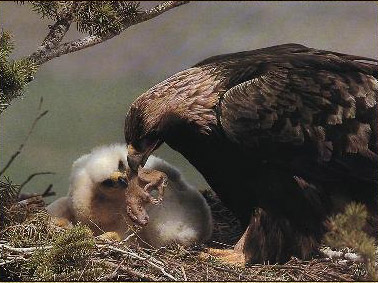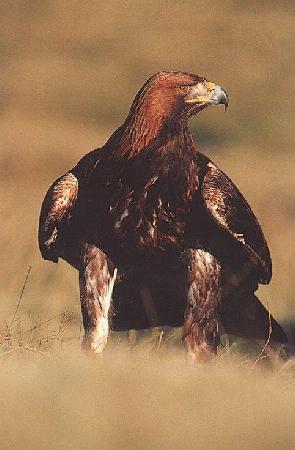|
 Along
the hills that looked over a forested land, lived a great eagle of black feathers and wild eyes. He perched on
the highest point, which was rocky and ragged. Along
the hills that looked over a forested land, lived a great eagle of black feathers and wild eyes. He perched on
the highest point, which was rocky and ragged.
Just below him was the nest where his two young sons and one daughter sat, hungry and eager for adventure.
They screeched at their father, begging to go out on their own for a few hours. They wanted to see things for themselves.
They liked the stories their parents told them, but they wanted to see life outside the nest with their own eyes.
One day the father eagle grew tired of their screeching and told them they could go out by themselves until the
sun was directly overhead. They scrambled out of their nest, laughing and singing. They started to go down the
rocky hill, not realizing how steep it was and they ended up tumbling half way down the hill, rolling, hitting
rocks, scratching themselves on the sharp weeds.
Father eagle looked down at them and just shook his head. He felt one of his feathers moan. He looked down at the
feather and was shocked to see that it had turned gray.
 So, the process had begun; the graying of aneagle along the path of his growing and wild children.
Father eagle chuckled to himselfas he watched his children, remembering what he did when he was young eagle. So, the process had begun; the graying of aneagle along the path of his growing and wild children.
Father eagle chuckled to himselfas he watched his children, remembering what he did when he was young eagle.
One evening at sunset, young eagle decided to go on a night-flight on his own, without telling his parents. He
took off into the darkening sky with confidence.
As he moved into the night a great wind came over the forest and set the tree topes to dancing and swaying.
Young eagle was flying low and misjudged one of the tree tops. The tree scraped his belly, grabbed at his wings
and almost took him down. Young eagle barely got away.
He then decided to fly really low, through the branches of the trees.
 Suddenly he came upon a great owl, the owl was so frightened that he shot straight up towards young
eagle and slammed into young eagle's left wing. Suddenly he came upon a great owl, the owl was so frightened that he shot straight up towards young
eagle and slammed into young eagle's left wing.
They both fell towards the ground, but managed to pull out of the fall with their strong wings.
Young eagle went on his way, moving in a zig zag, for he was still dizzy from the collision.
 When he returned to his home at sunrise, he was bruised and scratched up; his father was perched
above the nest, angry, not a feather moving. Young eagle knew he was in trouble, but he noticed a small smile of
pride at the corners of his father's eyes. He looked at the left wing of his father, one of the feathers was gray.
Young eagle wondered what had happened. When he returned to his home at sunrise, he was bruised and scratched up; his father was perched
above the nest, angry, not a feather moving. Young eagle knew he was in trouble, but he noticed a small smile of
pride at the corners of his father's eyes. He looked at the left wing of his father, one of the feathers was gray.
Young eagle wondered what had happened.
Now, in the time of his own children, he knew what happened. There is no end to this story.
By Phil Goldvarg
Hgold42734@aol.com
Print and Color Your Own Eagle
Eagle's Landing
|

 Along
the hills that looked over a forested land, lived a great eagle of black feathers and wild eyes. He perched on
the highest point, which was rocky and ragged.
Along
the hills that looked over a forested land, lived a great eagle of black feathers and wild eyes. He perched on
the highest point, which was rocky and ragged.  So, the process had begun; the graying of aneagle along the path of his growing and wild children.
Father eagle chuckled to himselfas he watched his children, remembering what he did when he was young eagle.
So, the process had begun; the graying of aneagle along the path of his growing and wild children.
Father eagle chuckled to himselfas he watched his children, remembering what he did when he was young eagle. Suddenly he came upon a great owl, the owl was so frightened that he shot straight up towards young
eagle and slammed into young eagle's left wing.
Suddenly he came upon a great owl, the owl was so frightened that he shot straight up towards young
eagle and slammed into young eagle's left wing. When he returned to his home at sunrise, he was bruised and scratched up; his father was perched
above the nest, angry, not a feather moving. Young eagle knew he was in trouble, but he noticed a small smile of
pride at the corners of his father's eyes. He looked at the left wing of his father, one of the feathers was gray.
Young eagle wondered what had happened.
When he returned to his home at sunrise, he was bruised and scratched up; his father was perched
above the nest, angry, not a feather moving. Young eagle knew he was in trouble, but he noticed a small smile of
pride at the corners of his father's eyes. He looked at the left wing of his father, one of the feathers was gray.
Young eagle wondered what had happened. GENERAL
INFORMATION
GENERAL
INFORMATION HABITS AND HABITATS
HABITS AND HABITATS